Hanchao Yu
CAFe: Unifying Representation and Generation with Contrastive-Autoregressive Finetuning
Mar 25, 2025Abstract:The rapid advancement of large vision-language models (LVLMs) has driven significant progress in multimodal tasks, enabling models to interpret, reason, and generate outputs across both visual and textual domains. While excelling in generative tasks, existing LVLMs often face limitations in tasks requiring high-fidelity representation learning, such as generating image or text embeddings for retrieval. Recent work has proposed finetuning LVLMs for representational learning, but the fine-tuned model often loses its generative capabilities due to the representational learning training paradigm. To address this trade-off, we introduce CAFe, a contrastive-autoregressive fine-tuning framework that enhances LVLMs for both representation and generative tasks. By integrating a contrastive objective with autoregressive language modeling, our approach unifies these traditionally separate tasks, achieving state-of-the-art results in both multimodal retrieval and multimodal generative benchmarks, including object hallucination (OH) mitigation. CAFe establishes a novel framework that synergizes embedding and generative functionalities in a single model, setting a foundation for future multimodal models that excel in both retrieval precision and coherent output generation.
Towards An Efficient LLM Training Paradigm for CTR Prediction
Mar 02, 2025Abstract:Large Language Models (LLMs) have demonstrated tremendous potential as the next-generation ranking-based recommendation system. Many recent works have shown that LLMs can significantly outperform conventional click-through-rate (CTR) prediction approaches. Despite such promising results, the computational inefficiency inherent in the current training paradigm makes it particularly challenging to train LLMs for ranking-based recommendation tasks on large datasets. To train LLMs for CTR prediction, most existing studies adopt the prevalent ''sliding-window'' paradigm. Given a sequence of $m$ user interactions, a unique training prompt is constructed for each interaction by designating it as the prediction target along with its preceding $n$ interactions serving as context. In turn, the sliding-window paradigm results in an overall complexity of $O(mn^2)$ that scales linearly with the length of user interactions. Consequently, a direct adoption to train LLMs with such strategy can result in prohibitively high training costs as the length of interactions grows. To alleviate the computational inefficiency, we propose a novel training paradigm, namely Dynamic Target Isolation (DTI), that structurally parallelizes the training of $k$ (where $k >> 1$) target interactions. Furthermore, we identify two major bottlenecks - hidden-state leakage and positional bias overfitting - that limit DTI to only scale up to a small value of $k$ (e.g., 5) then propose a computationally light solution to effectively tackle each. Through extensive experiments on three widely adopted public CTR datasets, we empirically show that DTI reduces training time by an average of $\textbf{92%}$ (e.g., from $70.5$ hrs to $5.31$ hrs), without compromising CTR prediction performance.
BRIDLE: Generalized Self-supervised Learning with Quantization
Feb 04, 2025



Abstract:Self-supervised learning has been a powerful approach for learning meaningful representations from unlabeled data across various domains, reducing the reliance on large labeled datasets. Inspired by BERT's success in capturing deep bidirectional contexts in natural language processing, similar frameworks have been adapted to other modalities such as audio, with models like BEATs extending the bidirectional training paradigm to audio signals using vector quantization (VQ). However, these frameworks face challenges, notably their dependence on a single codebook for quantization, which may not capture the complex, multifaceted nature of signals. In addition, inefficiencies in codebook utilization lead to underutilized code vectors. To address these limitations, we introduce BRIDLE (Bidirectional Residual Quantization Interleaved Discrete Learning Encoder), a self-supervised encoder pretraining framework that incorporates residual quantization (RQ) into the bidirectional training process, and is generalized for pretraining with audio, image, and video. Using multiple hierarchical codebooks, RQ enables fine-grained discretization in the latent space, enhancing representation quality. BRIDLE involves an interleaved training procedure between the encoder and tokenizer. We evaluate BRIDLE on audio understanding tasks using classification benchmarks, achieving state-of-the-art results, and demonstrate competitive performance on image classification and video classification tasks, showing consistent improvements over traditional VQ methods in downstream performance.
CompCap: Improving Multimodal Large Language Models with Composite Captions
Dec 06, 2024



Abstract:How well can Multimodal Large Language Models (MLLMs) understand composite images? Composite images (CIs) are synthetic visuals created by merging multiple visual elements, such as charts, posters, or screenshots, rather than being captured directly by a camera. While CIs are prevalent in real-world applications, recent MLLM developments have primarily focused on interpreting natural images (NIs). Our research reveals that current MLLMs face significant challenges in accurately understanding CIs, often struggling to extract information or perform complex reasoning based on these images. We find that existing training data for CIs are mostly formatted for question-answer tasks (e.g., in datasets like ChartQA and ScienceQA), while high-quality image-caption datasets, critical for robust vision-language alignment, are only available for NIs. To bridge this gap, we introduce Composite Captions (CompCap), a flexible framework that leverages Large Language Models (LLMs) and automation tools to synthesize CIs with accurate and detailed captions. Using CompCap, we curate CompCap-118K, a dataset containing 118K image-caption pairs across six CI types. We validate the effectiveness of CompCap-118K by supervised fine-tuning MLLMs of three sizes: xGen-MM-inst.-4B and LLaVA-NeXT-Vicuna-7B/13B. Empirical results show that CompCap-118K significantly enhances MLLMs' understanding of CIs, yielding average gains of 1.7%, 2.0%, and 2.9% across eleven benchmarks, respectively.
RoAST: Robustifying Language Models via Adversarial Perturbation with Selective Training
Dec 07, 2023Abstract:Fine-tuning pre-trained language models (LMs) has become the de facto standard in many NLP tasks. Nevertheless, fine-tuned LMs are still prone to robustness issues, such as adversarial robustness and model calibration. Several perspectives of robustness for LMs have been studied independently, but lacking a unified consideration in multiple perspectives. In this paper, we propose Robustifying LMs via Adversarial perturbation with Selective Training (RoAST), a simple yet effective fine-tuning technique to enhance the multi-perspective robustness of LMs in a unified way. RoAST effectively incorporates two important sources for the model robustness, robustness on the perturbed inputs and generalizable knowledge in pre-trained LMs. To be specific, RoAST introduces adversarial perturbation during fine-tuning while the model parameters are selectively updated upon their relative importance to minimize unnecessary deviation. Under a unified evaluation of fine-tuned LMs by incorporating four representative perspectives of model robustness, we demonstrate the effectiveness of RoAST compared to state-of-the-art fine-tuning methods on six different types of LMs, which indicates its usefulness in practice.
MMViT: Multiscale Multiview Vision Transformers
Apr 28, 2023Abstract:We present Multiscale Multiview Vision Transformers (MMViT), which introduces multiscale feature maps and multiview encodings to transformer models. Our model encodes different views of the input signal and builds several channel-resolution feature stages to process the multiple views of the input at different resolutions in parallel. At each scale stage, we use a cross-attention block to fuse information across different views. This enables the MMViT model to acquire complex high-dimensional representations of the input at different resolutions. The proposed model can serve as a backbone model in multiple domains. We demonstrate the effectiveness of MMViT on audio and image classification tasks, achieving state-of-the-art results.
SVT: Supertoken Video Transformer for Efficient Video Understanding
Apr 23, 2023



Abstract:Whether by processing videos with fixed resolution from start to end or incorporating pooling and down-scaling strategies, existing video transformers process the whole video content throughout the network without specially handling the large portions of redundant information. In this paper, we present a Supertoken Video Transformer (SVT) that incorporates a Semantic Pooling Module (SPM) to aggregate latent representations along the depth of visual transformer based on their semantics, and thus, reduces redundancy inherent in video inputs.~Qualitative results show that our method can effectively reduce redundancy by merging latent representations with similar semantics and thus increase the proportion of salient information for downstream tasks.~Quantitatively, our method improves the performance of both ViT and MViT while requiring significantly less computations on the Kinectics and Something-Something-V2 benchmarks.~More specifically, with our SPM, we improve the accuracy of MAE-pretrained ViT-B and ViT-L by 1.5% with 33% less GFLOPs and by 0.2% with 55% less FLOPs, respectively, on the Kinectics-400 benchmark, and improve the accuracy of MViTv2-B by 0.2% and 0.3% with 22% less GFLOPs on Kinectics-400 and Something-Something-V2, respectively.
Uniform Masking Prevails in Vision-Language Pretraining
Dec 10, 2022


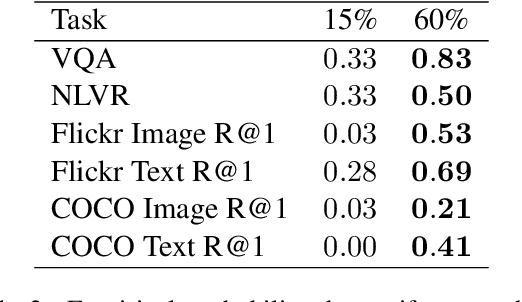
Abstract:Masked Language Modeling (MLM) has proven to be an essential component of Vision-Language (VL) pretraining. To implement MLM, the researcher must make two design choices: the masking strategy, which determines which tokens to mask, and the masking rate, which determines how many tokens to mask. Previous work has focused primarily on the masking strategy while setting the masking rate at a default of 15\%. In this paper, we show that increasing this masking rate improves downstream performance while simultaneously reducing performance gap among different masking strategies, rendering the uniform masking strategy competitive to other more complex ones. Surprisingly, we also discover that increasing the masking rate leads to gains in Image-Text Matching (ITM) tasks, suggesting that the role of MLM goes beyond language modeling in VL pretraining.
Study Group Learning: Improving Retinal Vessel Segmentation Trained with Noisy Labels
Mar 05, 2021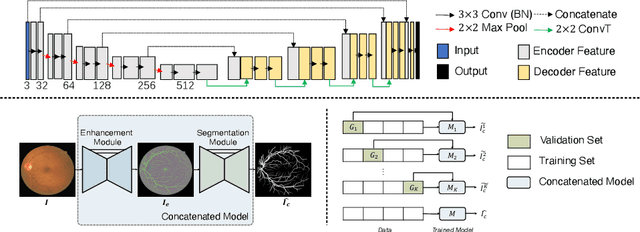



Abstract:Retinal vessel segmentation from retinal images is an essential task for developing the computer-aided diagnosis system for retinal diseases. Efforts have been made on high-performance deep learning-based approaches to segment the retinal images in an end-to-end manner. However, the acquisition of retinal vessel images and segmentation labels requires onerous work from professional clinicians, which results in smaller training dataset with incomplete labels. As known, data-driven methods suffer from data insufficiency, and the models will easily over-fit the small-scale training data. Such a situation becomes more severe when the training vessel labels are incomplete or incorrect. In this paper, we propose a Study Group Learning (SGL) scheme to improve the robustness of the model trained on noisy labels. Besides, a learned enhancement map provides better visualization than conventional methods as an auxiliary tool for clinicians. Experiments demonstrate that the proposed method further improves the vessel segmentation performance in DRIVE and CHASE$\_$DB1 datasets, especially when the training labels are noisy.
Measure Anatomical Thickness from Cardiac MRI with Deep Neural Networks
Aug 25, 2020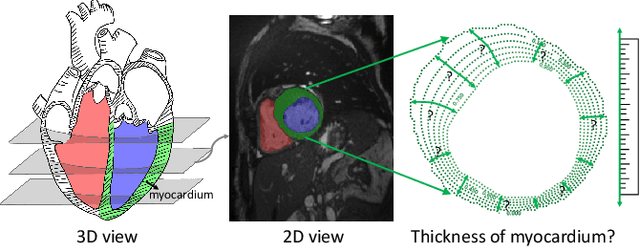

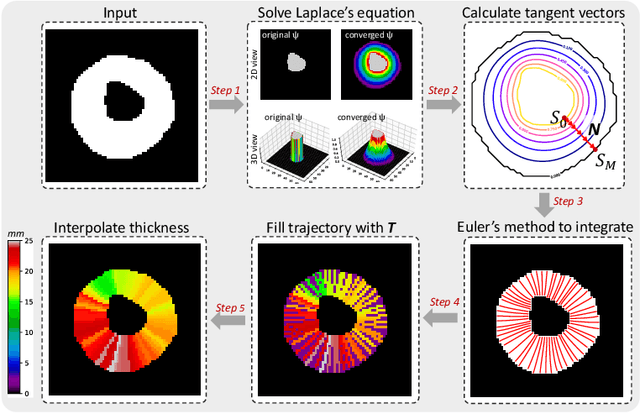
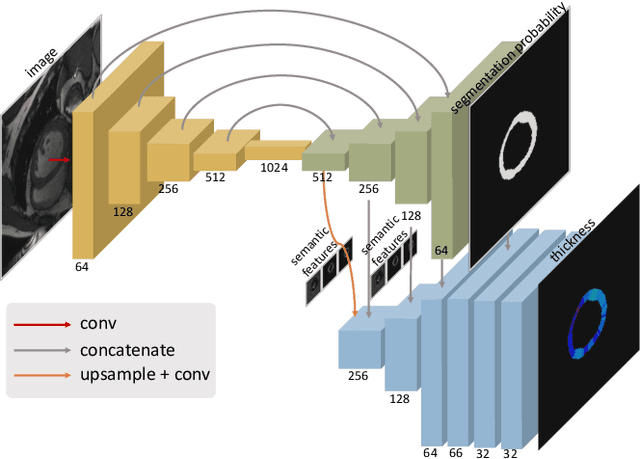
Abstract:Accurate estimation of shape thickness from medical images is crucial in clinical applications. For example, the thickness of myocardium is one of the key to cardiac disease diagnosis. While mathematical models are available to obtain accurate dense thickness estimation, they suffer from heavy computational overhead due to iterative solvers. To this end, we propose novel methods for dense thickness estimation, including a fast solver that estimates thickness from binary annular shapes and an end-to-end network that estimates thickness directly from raw cardiac images.We test the proposed models on three cardiac datasets and one synthetic dataset, achieving impressive results and generalizability on all. Thickness estimation is performed without iterative solvers or manual correction, which is 100 times faster than the mathematical model. We also analyze thickness patterns on different cardiac pathologies with a standard clinical model and the results demonstrate the potential clinical value of our method for thickness based cardiac disease diagnosis.
 Add to Chrome
Add to Chrome Add to Firefox
Add to Firefox Add to Edge
Add to Edge